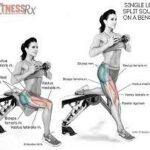Butt Blast: Tighten Your Tush With Single-Leg Squats

There is no simple formula for obtaining a firm, toned butt. Sorry, but the “Butt Fairy” is not going to swoop into your living room, wave her magic wand and proclaim, “Be gone, flabby tush.” A tight and toned backside requires a healthy diet (ditch the sugar, bread, and dairy) plus some serious weight training that will target your posterior. In the quest for the perfect butt, some exercises work better than others. The best exercise for toning, shaping, and targeting the butt muscles is the single-leg squat.
Single-leg squats don’t just tighten your butt – they are the #1 overall exercise for building lean body mass. A big reason for their lean body mass building and toning ability is that single-leg squats provide constant tension during your workout – which activates all the muscle fibers during the set. When it comes to fat loss (and getting a smaller butt), having more lean body mass makes all the difference in the world. The greater amount of lean body mass (i.e., muscle) you have, the less fat you have, because lean mass acts like an inner furnace that burns fat, 24/7. It’s a win-win situation – except for your butt, which loses a few inches.
Muscles Activated
Because the muscles of your butt are closely involved when you move your legs, many leg exercises (such as single-leg squats) also work your glutes. There are three main glute muscles. The largest is the gluteus maximus. It forms the bulk of your posterior mass. The gluteus medius lies beneath the gluteus maximus but is not as big. The third muscle, the gluteus minimus, is the smallest and deepest of the three backside muscles.
Moving down on the anatomy chart, your anterior thigh (which also gets a great workout from single-leg squats) consists of four major muscles that are collectively known as the quadriceps femoris (“quadriceps” or “quads”). The vastus lateralis muscle lies on the lateral (outer) part of the thigh over the lateral part of the femur bone of the thigh. The vastus medialis covers the medial (inner) part of the thigh. The vastus intermedius is located intermediately on the femur bone, between the vastus lateralis and the vastus medialis, and covers the central and deeper parts of the thigh. The fourth muscle is the rectus femoris. The top part of this muscle attaches to the hip and it courses down the central portion of the thigh.
All four muscles of the anterior thigh come together above the knee to attach to the patellar tendon. This attaches to the patella (kneecap), and the patellar ligament attaches the patella to the top part of the tibia bone just below the knee. Together, the quadriceps extend (straighten) the leg at the knee joint by pulling on the patella and through it, the patellar ligament that is attached to the lower leg (tibia bone). The rectus femoris also flexes the thigh at the hip joint by pulling the knee and thigh toward the chest. The rectus femoris muscle is a weak knee extensor when the hip is flexed (e.g., in a deep squat).
1. Place a bench behind a fixed, vertical pole such as the base of a Smith or cable machine. Hold on to the pole with one hand to keep your balance during the squat. You can do the exercise without holding on to a pole, but without perfect balance, you could be headed to the floor in a hurry.
2. If you exercise the right leg first, flex the knee of your left leg (non-working leg) to about 90 degrees and place the top portion of your left foot on the bench (which is placed behind you). This leg position will help maintain your balance.
3. The toes on the working (right) leg should be angled slightly outward. This angle produces a more direct line of pull of the patellar tendon across the patella than if the knee was straight.
4. Shift your bodyweight to your right leg, and slowly lower your body by flexing your right knee. Keep your back straight and your eyes and head looking straight ahead, as you lower your body. Continue to lower your buttocks toward the floor until your knee is about 90 degrees.
5. Rise upward by straightening your right knee, but do not allow it to “lock” out. This will maintain tension on the thigh muscles. Do not let your eyes focus on the floor when you are going up or down, because this will decrease your stability and you may lose your balance during squatting.
6. After completing about 10 reps with your right leg, take a short break. Reposition your right leg so that the top of your right footrests on the bench, and then start your squats for the left leg.
You can add more reps as you improve your muscle strength and stamina. After accomplishing about 2 sets of 20 reps with each leg, you will be ready to hold a dumbbell in one hand. When holding a dumbbell, be careful not to allow your body to twist while you are squatting, as this could increase the chances of injury to your lower back.
It is important to keep a fluid, smooth motion in both directions. This will maintain constant tension on the thigh and glutes of the working leg throughout the entire set. Do not rest at the top of the exercise – this will eliminate the constant tension on the muscles, and the weight will be transferred away from your muscles and to the bones of the thigh, leg, and glutes.
You should never bounce into the bottom position in an attempt to shoot upward. In addition, it would be wise to avoid the exercise altogether if you have a prior knee injury. However, if your knees are healthy and you would like your butt to be toned and tight – single-leg squats (with added resistance from dumbbells) may be just the right exercise for your butt-shaping program.
Don’t think that this is an easy exercise, just because you are working one limb at a time. Rather, this is a very tough exercise. As you work through each set, your thighs and butt will scream for oxygen-saturated blood. Nevertheless, as you become mentally tougher, you will ignore their pleas for mercy and continue to pump and shock your thighs and glutes – rep after rep. Don’t expect this type of mental toughness to arrive overnight, but it will come.
References:
Ebben WP, Fauth ML, Kaufmann CE, Petushek EJ. Magnitude and rate of mechanical loading of a variety of exercise modes. J Strength Cond Res, 2010; 24:213-217.
Schwanbeck S, Chilibeck PD, Binsted G. A comparison of free weight squat to Smith machine squat using electromyography. J Strength Cond Res, 2009; 23:2588-2591.
Paoli A, Marcolin G, Petrone N. The effect of stance width on the electromyographical activity of eight superficial thigh muscles during back squat with different bar loads. J Strength Cond Res, 2009; 23:246-250.
Frohm A, Halvorsen K, Thorstensson A. Patellar tendon load in different types of eccentric squats. Clin Biomech, 2007; 22:704-711.
Moore KL and Dalley AF. Clinically Oriented Anatomy, Fourth Edition. Baltimore, Lippincott Williams & Williams, Kelly PJ, Editor, 1999, pp. 531-549.
Rahmani A, Viale F, Dalleau G, & Lacour JR. (2001). Force/velocity and power/velocity relationships in squat exercise. Eur J Appl Physiol, 84, 227-232.









